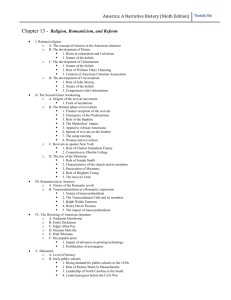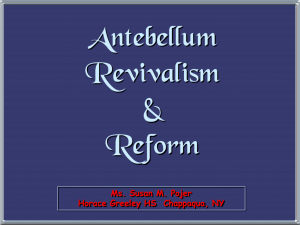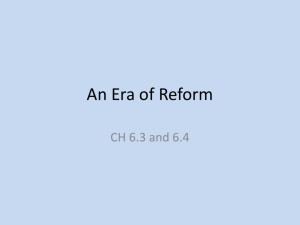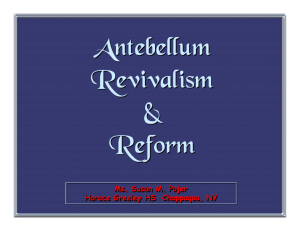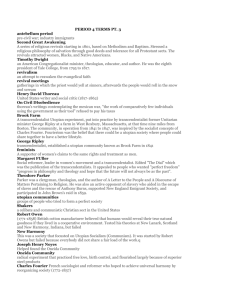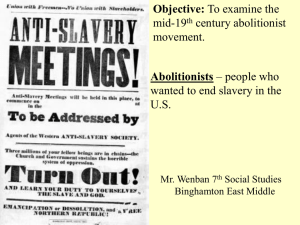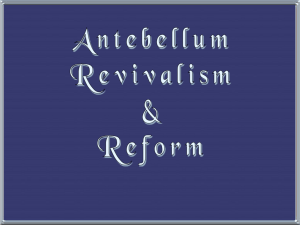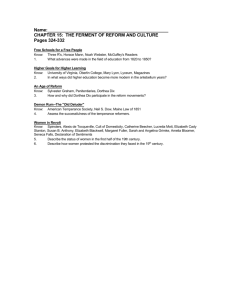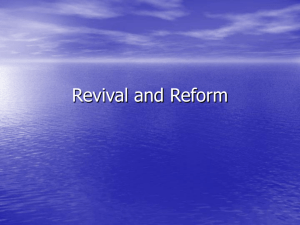USH Chap2 Reformers
advertisement
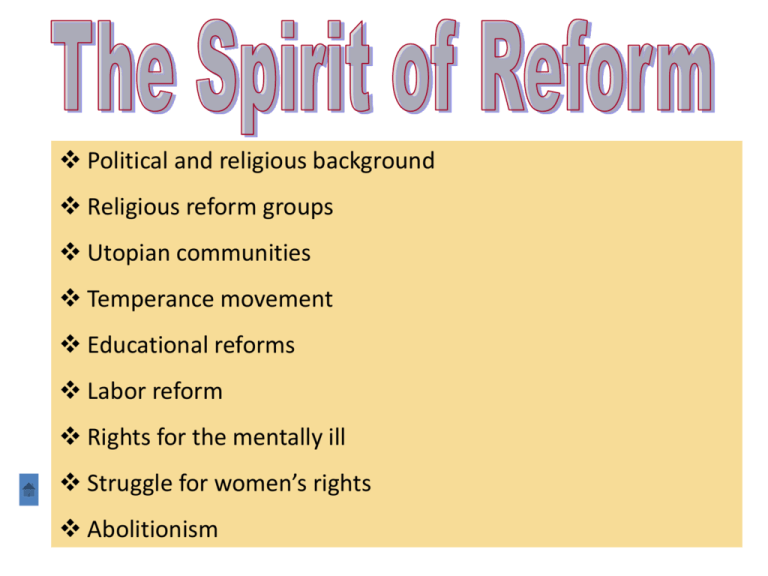
Political and religious background Religious reform groups Utopian communities Temperance movement Educational reforms Labor reform Rights for the mentally ill Struggle for women’s rights Abolitionism Women’s rights Legal code and prison reform Rights for the mentally ill Anti-slavery Reform Movements Educational reform Temperance Utopian communities Religious Reform groups Political and religious background of reform In the early 1800s, a huge religious movement known as the Second Great Awakening swept the U.S. Massive religious meetings known as revivals or camp meetings were held throughout the nation. Protestant philosophy changed to include a belief that doing good and helping solve societies problems was a path to salvation. The concept of the social gospel, a belief in helping others, which brought needed reforms at the beginning of the 20th century had its origins here. Charles Grandison Finney Called "America's foremost revivalist." Christian evangelist said to have converted 500,000 people in large outdoor meetings called revivals or camp meetings. Major leader of the “Second Great Awakening” religious revival that swept parts of America in the early years of the 19th century. Differed from the older Calvinist Christian tradition that believed man was predestined (born to go to heaven or hell) and could do nothing to change his or her fate. Finney believed that people could choose their salvation by doing good works. He believed in free will rather then predestination. Active in the abolitionist movement, condemning slavery from his pulpit. Supported temperance and women’s rights. Finney Religious reform groups The Shakers were a breakaway group from the Quakers which started in England in the late 18th century. A group moved to New York and later to other states. Believed in a new way of life: abolished families, practiced celibacy, and full equality between sexes. Shaker dance Families in Shaker society were completely segregated, houses had separate entrances for men and women. Shaker sewing table They did not believe in procreation, so the only ways to gain new members was through adoption or conversion. Their simple, functional furniture designs, music, dancing, and self-published books became popular. Shaker dance Amana villages, 1855 to 1932 Founded by German immigrants in 1843 in New York, later settled in Iowa in 1855. The Amanas based their society on Christian ideals. The community provided each family with a home and monthly allowance at the general store. Medical care was provided free by the community. Each person was expected to work and was assigned a job by the community Elders based on the needs of the community as well as the talents of the individual. The Church of Jesus Christ of Latter-day Saints The Mormons were organized by Joseph Smith in New York in 1830. Smith and his followers moved to Illinois, where he was murdered by opponents. Brigham Young succeeded him and led migration to Utah. During the crossing to Utah, Church leaders encouraged wealthy and established men to take additional wives to help widows and their children, as well as young women without families. The practice of polygamy was publicly announced by the Church in 1852. Joseph Smith Brigham Young Oneida Started by John Humphrey Noyes in Oneida, NY in 1848 as a religious community Lived communally where everyone shared everything including work, food, possessions, and living space. Among other beliefs, the community rejected "exclusive love" and considered all men married to all women Practiced “mutual criticism” in which actions were reprimanded in front of a committee or sometimes even the entire community Lasted about 30 years Non-religious utopian communities Utopia is defined as a perfect place. Robert Owen founded a socialist community in New Harmony, Illinois in 1825. He believed everyone should contribute to make it self-sufficient and not need currency. It failed after several years. Brook Farm experiment Founded in 1841 in Massachusetts by former Unitarian minister George Ripley to live self-sufficiently. Influenced by transcendentalist thought, which rejected organized religion as the source for enlightenment, emphasized individualism and the mysteries of nature. They preferred to live apart from society due to the unequal and unfair treatment of individuals. Influenced many important writers such as Hawthorne and Thoreau. Lasted only until 1847 mostly due to its reliance upon agriculture and its location on infertile land. Ripley Locations of various communities in the mid-1800s Temperance Movement (anti-alcohol) American Temperance Society Began in 1826 to eliminate the consumption of alcoholic beverages. Estimated that the average American in the early 19th century consumed over four gallons of liquor a year. In 2000, the average was just over two gallons a year. Made up mostly of women who saw “demon rum” as the number one enemy. In the years before the Civil War (antebellum) the main focus was to get men to sign pledges promising not to drink alcoholic beverages. Later anti-alcohol organizations such as the Woman's Christian Temperance Union (WCTU) worked to make alcoholic beverages illegal. “The Drunkard's Progress/From the First Glass to the Grave”, 1846 Step 4 Step 3 A glass too Drunk and riotous much Step 1 A glass with a friend Step 5 The summit attained...Jolly companions...A Step 6 confirmed drunkard Poverty and disease Step 2 A glass to keep the cold out Wife and daughter weeping outside the burning house, in the distance is a prison. Step 7 Forsaken by Friends Step 8 Desperation and Crime Step 9 Death by suicide By 1840, there were over 2,000 temperance societies in the United States. 70,000 members signed pledges, like those below, promising abstinence from alcoholic beverages. Educational Reform Free public education was rare before the 1820s. A movement for “common schools” began in Massachusetts during the period of 1830-1850 to Americanize new immigrants. Horace Mann was an important leader in the movement which advocated compulsory education. Common schools were designed to have a similar educational experience for all children regardless of class or locale. Common schools were viewed as a vehicle to preserve rural values in new urban society. Normal schools were established to train teachers. Mann McGuffey's Readers The original 1836 version of the reading books used for 75 years by about 80% of all American students. Some 120 million sets were sold. No other books ever had this much influence over so many children over such a long period. Labor Reform Unions began to form after the Revolutionary War in cities such as Philadelphia and Baltimore. In the 1820s the Mechanics' Union of Trade Associations, the first to combine different types of unions, formed. Their goals were not only higher wages and improved working conditions but also free public schools, abolition of debtors jail, and universal male suffrage. The Union entered politics to secure their goals. Preamble of the Mechanics' Union of Trade Associations (Philadelphia, 1828) “We, the Journeymen Mechanics of the City and County of Philadelphia, conscious that our condition in society, is lower than justice demands it should be, and feeling our inability, individually, to ward off from ourselves and families those numerous evils which result from an unequal and very excessive accumulation of wealth and power into the hands of a few, are desirous of forming an Association, which shall avert as much as possible those evils with which poverty and incessant toil have already inflicted, and which threaten ultimately to, overwhelm and destroy us…” A family in debtor’s prison Up until the mid-19th century, a person could be put in jail if they could not pay back money owed. Early unions pushed to have debtors jails abolished. Child labor was widespread in the 19th and early 20th centuries, for example, in New England about 30% of workers were children under 16. Unions In the late 1820s, unions entered politics with the Working Men's Party. It was made up of craftsmen, skilled journeymen, and reformers who sought a 10-hour workday, free public education, abolition of debtor imprisonment, and an end to prison contract labor. The party ended in the 1830s, and several New York members joined the Locofoco Party, a radical faction of the New York State Democratic Party. Many of the early labor unions were destroyed by the economic collapse caused by the Panic of 1837. Nearly 30% of U.S. workers lost their jobs. Labor unions made a comeback in the 1840s and 1850s but were again devastated by the economic crisis of the Panic of 1857. Unions came back strongly after the Civil War. Major antebellum (period between the Revolutionary and Civil Wars) labor accomplishments In 1840, President Van Buren established a ten hour work day for all federal employees. In 1842, the Massachusetts Supreme Court ruled that labor unions were not illegal conspiracies. In 1842, children were prohibited from working over ten hours a day. In 1847, New Hampshire made ten hours the legal workday. In 1848, Pennsylvania passed a law to make 12 the minimum age for child workers. In 1848, Pennsylvania passed a ten hour work day. Average workday was 11 hours per day From a report on Lowell, a mill in Massachusetts, working conditions in 1846 “Thus thirteen hours per day of close attention and monotonous labor are exacted from the young women in these manufactories. . . So fatigued-we should say, exhausted and worn out but we wish to speak of the system in the simplest languageare numbers o f the girls, that they go to bed soon after their evening meal? and endeavor by a comparatively long sleep to resuscitate their weakened frames for the toils of the coming day. “ Growth in manufacturing jobs including textile factories, 18201860 total manufacturing jobs 1,600,000 1,400,000 1,200,000 1,000,000 800,000 600,000 400,000 200,000 0 1820 1830 1840 1850 1860 Dorothea Dix In the mid-1820s, she discovered the mentally ill in Massachusetts were kept locked in prisons in unsanitary, unheated cells chained to the walls. They were naked, filthy, underfed, and sleeping on stone floors. Began a lifelong campaign to improve conditions for mentally ill persons. Instrumental in getting Massachusetts to build a mental hospital and later went on to work for mental institutions in other states. Women mobilized for rights The Second Great Awakening inspired women to do things they had never done before. Many women, for the first time, became active in activities outside their home and family. Women became active in temperance and abolition as well as other humanitarian causes. Women were considered inferior to men. They were not allowed to attend college, vote, or control their own property. Legally, women were their husband’s property. Many women were angry at their second class status and began organizing. The primary focus of the antebellum women's rights movement was obtaining civil rights for women. Women wanted equal property rights, divorce reform, custody of their children, and the right to vote. Rational Dress Movement A protest against the uncomfortable and constricting women's clothes began in 1851 when Libby Miller developed what became known as the bloomer style. Called “Bloomers” after The Lily magazine editor Amelia Bloomer promoted the new style. Women were harassed and bloomers disappeared until the end of the 19th century. Dresses from the 1840s and 50s In 1840, the World Antislavery Convention was held in London. While women were encouraged to take an active part in American antislavery societies, they were not allowed to be delegates at the London Convention. This so angered American delegates Elizabeth Cady Stanton and Lucretia Mott that they decided to hold their own meeting to promote women’s rights. The meetings took place in 1848 in New York. 1840 World Antislavery Convention in London American abolitionists from the 1840s: Lucretia Mott Seneca Falls Convention New York 1848: the beginning of the women’s movement in the U.S. Organized by Lucretia Mott and Elizabeth Cady Stanton. Their purpose was to discuss the social, civil, and religious condition and rights of women. They wanted to publicize the second class status of women and begin the fight to remedy it. Over 300 attended. A series of declarations was passed. The issue of female suffrage met serious opposition until a speech by Frederick Douglass convinced the delegates to pass a declaration demanding it. Only one Convention attendee, 19 year old Charlotte Woodward lived to see women win the vote in 1920. Frederick Douglass The Declaration of Sentiments was based on the Declaration of Independence: “We hold these truths to be self-evident: that all men and women are created equal; that they are endowed by their Creator with certain inalienable rights…The history of mankind is a history of repeated injuries and usurpations on the part of man toward woman, having in direct object the establishment of an absolute tyranny over her. …He has withheld from her rights which are given to the most ignorant and degraded men-both natives and foreigners…RESOLVED, That it is the duty of the women of this country to secure to themselves their sacred right to the elective franchise.” Elizabeth Cady Stanton author of the Declaration. Photo with two of her seven children. In 1851 Susan B. Anthony and Elizabeth Cady Stanton became partners in the suffrage movement. Although their efforts directly led to passage of the 19th amendment, neither lived to see it. The women's rights movement grew out of the anti-slavery movement. In 1851 at a convention in Akron, Ohio, former slave, abolitionist, and women’s rights advocate Sojourner Truth gave a stirring speech titled "Ain't I a Woman?". Quotes from her speech "Well, children, where there is so much racket, there must be something out of kilter, I think between the Negroes of the South and the women of the North - all talking about rights - the white men will be in a fix pretty soon… "That little man in black( a minister) there! He says women can't have as much rights as men. ‘Cause Christ wasn't a woman. "Where did your Christ come from?", From God and a Woman! Man had nothing to do with him!“ "If the first woman God ever made was strong enough to turn the world upside down all alone, these women together ought to be able to turn it back and get it right-side up again. And now that they are asking to do it, the men better let them." Mott Lucretia Mott, E. Cady Stanton, Mary A. Livermore, Lydia Maria Child, Susan B. Anthony, Grace Greenwood, Anna E. Dickinson Lucy Stone Higher education for women Higher education for women did not exist before 1821. In 1821, Emma Hart Willard founded the Troy Female Seminary in New York, the first endowed school for girls. Oberlin College became the first coeducational college in the United States in 1833. In 1837, Mount Holyoke College, the first established for women opened. Troy Oberlin Mount Holyoke 1859 print shows a group of women in a hall listening to a woman speaker pointing to the men sitting in an upper gallery. Usually women were made to sit in upper galleries away from the action below. The abolitionist movement organized in 1833, when William Lloyd Garrison, Arthur and Lewis Tappan, and others formed the American Anti-Slavery Society in Philadelphia. Abolitionists believed slavery was a national sin, and it was the moral obligation of every American to help eradicate it. Through his newspaper, The Liberator, Garrison spoke out against slavery and for the rights of black Americans. From the very first issue in 1831, Garrison made it clear he would be a strong advocate for the total abolition of slavery and full citizenship for African Americans. “On this subject, I do not wish to think, or speak, or write, with moderation. No! no! Tell a man whose house is on fire, to give a moderate alarm; tell him to moderately rescue his wife from the hand of the ravisher; tell the mother to gradually extricate her babe from the fire into which it has fallen; -- but urge me not to use moderation in a cause like the present. I am in earnest -- I will not equivocate -- I will not excuse -- I will not retreat a single inch -- AND I WILL BE HEARD.” Anti-slavery societies sprung up all over the north and west including the Salem, Massachusetts Female Anti-Slavery Society, the first to be founded by a black woman. Abolitionists faced hostility and violence in the early years of the anti slavery movement. In the early 1830s, Amos Dresser, a minister in Memphis, Tennessee, was arrested and publicly whipped by a committee of prominent citizens of Nashville, Tennessee for being a member of an Ohio anti-slavery society and possessing and disseminating anti-slavery materials. Who were some of the prominent Abolitionists? Gerrit Smith (1797-1874) was a wealthy New York abolitionist. He was the president of the New York Anti-Slavery Society for three years. Smith served as a Station Master on the Underground railroad. One of the Secret Six who gave financial assistance to John Brown for his raid at Harper’s Ferry. Smith ran for president three times and was the only abolitionist to hold a congressional office. Samuel J. May (1797-1871) was Unitarian minister. A pacifist who acted as a general agent of the Massachusetts Anti-Slavery Society and sheltered slaves on the Underground Railroad. William Seward (1801-1872), governor of New York from 1838-1842. He was elected to the U.S. Senate as a Whig party member in 1847. During the Civil War Lincoln made Seward his Secretary of State, and asked him to help write the Emancipation Proclamation. Seward also sheltered slaves on the Underground Railroad. Lucretia Mott (1793-1880) was a Quaker pacifist who was committed to black emancipation and women’s rights. After slavery was abolished in 1865, Mott supported the rights of Black Americans to vote. Lydia Maria Child (1802-1880) in 1833, wrote “An Appeal to that Class of Americans Called Africans,” an anti-slavery tract in which she declared her willingness to battle for emancipation. She was the editor of the National Anti-Slavery Standard, the American AntiSlavery Society’s newspaper. Sojourner Truth (1797-1883) was one of the best known and respected black women of the nineteenth century. Born a slave in New York, she escaped to New York City in 1827. She was a tireless worker in the abolition crusade and helped recruit Black soldiers during the Civil War. Sarah Grimke Angelina Grimke Sarah and Angelina Grimke were American feminists and social reformers who spent their lives working and leading in both the abolitionist and suffrage movements. They were refined, wealthy southern women, their speeches and writings against slavery attracted considerable attention.Sarah and Angelina Grimke were born in Charleston, South Carolina in 1792 and 1805 respectively. They were the daughters of John F. Grimke and Mary Smith Grimke. Their father was a slave-holding judge and their mother came from a family prominent in South Carolina politics. Together they set out to end the evil of slavery in our nation. Both sisters gave antislavery lectures in several Northeastern states and were some of the first women to lecture in public in the United States. Angelina appealed to the women of America to support their fight against slavery in her works "Appeal to the Christian Women of the South", published in1836 and "Appeal to Women of the Nominally Free States", published in 1837. Sarah, too, began to write to gain support for abolition and in 1836 she published "Epistle to the Clergy of the Southern States". Because of these and other writings, both were threatened with imprisonment if they were ever to return to South Carolina. Regardless, they freed their family's The abolitionist movement turned to politics Abolitionists tried various means to bring the slavery question to the federal government. The government, fearful of sectional strife, refused to deal with the slavery issue. The Liberty Party formed in 1840 to secure emancipation though the political process and repeal all racial discriminatory legislation. James G. Birney from Michigan, the executive secretary of the American Anti-Slavery Society, was the party's candidate for president in 1840 and 1844 Birney
